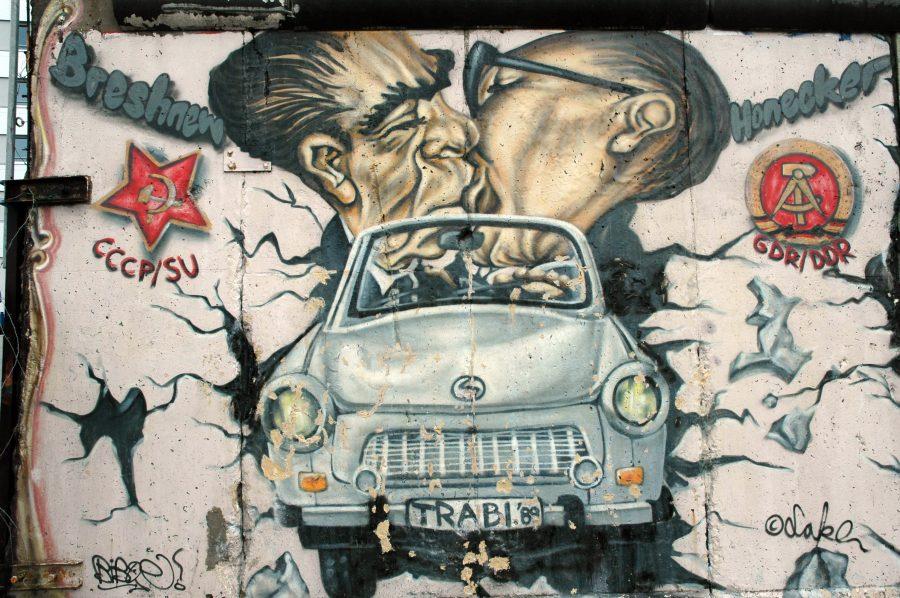Harrison’s exhibit, “The Berlin Wall Series,” will be displayed in the Arts Council Gallery at the Dinah Washington Cultural Arts Center this August, beginning with a reception on Aug. 7. Kevin Ledgewood, publicist for the Arts Council of Tuscaloosa, said the reception will honor Harrison and give a chance to address local patrons interested in his work.
“I was interested in how the texture and line and color played against each other,” Harrison said. “I was less concerned with whether the image looked like something. Most of what you get is abstract in how it appears. A lot of people when they see it for the first time think they’re paintings. The idea was to totally remove any visual frame of reference from the image so you focused on the abstract juxtaposition of color, line and texture.”
Ledgewood said the Arts Council was familiar with Harrison’s work and thought it would be a great addition to their lineup of exhibits.
“The Arts Council is extremely pleased to host Mr. Harrison’s photography exhibit,” he said. “Not only has he captured the extraordinary, emotional output of artists during a time of struggle, he has also given their work a voice through his documentation.”
Harrison, a Tuscaloosa native, is the owner and director of Harrison Galleries in downtown Tuscaloosa. His gallery stands in the same building as the drugstore his grandfather started working in 1920, the first store in the family’s drugstore chain, Harco Drug Company. The family sold the company to Rite Aid in 1997, and Harrison spent four years as a professional photographer in the western United States before returning home.
Harrison said the beginnings for his art gallery first started when he would accompany his wife, who was in the antique business, to shops. He said he bought paintings primarily for their home, but ended up with more than they could display. Harrison decided to buy back his family’s old building and turn it into a gallery. The gallery does 30 or 40 events a year, ranging from showcasing University of Alabama students’ works to hosting live jazz bands as part of First Friday, a local community arts event.
Almost 10 years since he first took the photos, Harrison said, unless the city of Berlin has done something to preserve the site, it will have deteriorated quite a bit. Unlike the section he photographed, he said there is a section of the wall left in Berlin known as the East Side Gallery, where artists are encouraged to take a section and do their own graffiti. It changes throughout the year.
“It is a marker of some historical significance, and quite frankly I think, it won’t be long before people won’t remember what that was all about,” he said. “I remember seeing the [television] newscast of people standing on the wall and pounding at it with sledge hammers. It was pretty momentous occasion. People in Germany were kind of ashamed of it. It was a tangible symbol of Cold War oppression. If you grew up in that time, you knew about the Berlin Wall.”
Harrison said he had been in Tuscaloosa in 1989 when he saw the Berlin Wall fall. He said it was an interesting event, watching the Soviet Union and Eastern Bloc countries collapse because it was essentially a revolution. The taking down of the wall was a symbol of a new world age in Europe and Germany.
Ledgewood said host galleries have primarily been involved in scheduling and publicity, and the majority of the responsibility falls upon the artists to perform tasks such as developing a price list and identification labels.
“Few people outside of the visual art community realize how much supplies and framing cost the artist, not to mention the responsibility of following through with the commitment once the exhibit is scheduled,” he said.
Harrison said the graffiti was beautiful work but wasn’t meant to be beautiful work. It was meant to be graffiti. He said the art work speaks to the nature of not only freedom but also expression. He said there was a stark contrast between the blank grey on the oppressed side and the expressions on the free side. Among the graffiti is a heart with the words, “I love you Star Girl,” inside.
“Well, you wonder who is Star Girl?” he said. “Obviously they didn’t care about the wall and what it represented, but it was a place where somebody expressed feelings for someone else. Now, they’re gone, and you don’t know who they are. All these artists are unknown and anonymous, but their work to some extent has lived beyond their existence.”
Harrison hopes to return to Berlin in the next few years and capture how the wall has changed over the past decade.









